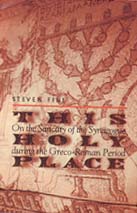This Holy Place: On the Sanctity of the Synagogue During the Greco-Roman Period
Steven Fine
(Notre Dame: Univ. of Notre Dame Press, 1997) 280 pp., $35.00 (hardback) $24.00 (paperback)

At some point during the first millennium, the synagogue was transformed from a place to meet one’s fellows into a house of meeting with God. Between the first and seventh century C.E., the synagogue’s scroll chest (teva) became an ark (aron), and the sacred laws of sanctity governing the Temple were increasingly applied to the synagogue.
What was the driving force behind this gradual “templization”—as Steven Fine puts it—of the synagogue? How did a multipurpose community center become a sacred space?
In This Holy Place, Fine, professor of rabbinic literature and history at Baltimore Hebrew University, traces this shift with unprecedented nuance and detail. As he notes, the Torah scrolls that were read, studied and stored in synagogues were the wellspring of synagogue sanctity. Moreover, with an ever-increasing chronological gap separating the Jews from God’s house, Temple motifs gained prominence as the synagogue and its liturgy evolved—most likely following the Roman destruction of the Jerusalem Temple in 70 C.E.
Fine observes that the earliest history of the synagogue (third century B.C.E. to first century C.E.) is still largely a mystery. But we do know that after 70 C.E. the synagogue became the space in which rituals with roots in the Temple were performed—even though the Tannaitic rabbis of the first and second centuries C.E. saw to it that synagogues would not supersede the Temple. They did this by drawing a clear distinction between the sanctity of the synagogue versus that of the Temple: Temple sanctity ranked higher than the hierarchy of holiness associated with a sacred book (hence no prostration was allowed in the synagogue). The notion of synagogue holiness may still have been, in Fine’s words, “somewhat tentative and generally inexplicit” in Tannaitic (early rabbinic) sources—after all, the Jerusalem Temple was without parallel.
But in the post-Tannaitic period, known as the Amoraic period (third through seventh centuries), ideas of synagogue holiness blossomed; in some instances, Temple imagery was so rigidly applied to synagogues that in some rabbinic sources menstruating women were excluded from services, as was the case in the Temple. It is in this period, moreover, that the scroll chest became an ark, a thing of magical power that brought about an increased ritualization of Torah reading. The Torah scroll had come to represent the Divine among the congregation (this is the source of the phrase da ‘liphne mi ’atta ‘omed, which means “know before whom you are standing,” inscribed on Torah shrines in present-day synagogues). Fine describes this development as “the remembrance of an idyllic past and anticipation of an ideal future.” It is confirmed by archaeological discoveries demonstrating that the Torah shrine and precinct, drawing its symbolism from the Temple, became the foremost defining feature of the synagogue building—not only in the land of Israel, but in the Diaspora as well.
Fine provides a plethora of drawings and photographs, impressive bibliographical coverage, and a wealth of detail (although his Greek is not always flawless), which almost amount to a full history of the synagogue in the first millennium of its existence. I would have liked to have seen, however, a more thorough treatment of how the Torah required the quality of holiness and became the major stimulus behind the development of the synagogue’s sanctity, since this process preceded the “templization.” Still, there can be no doubt that his monograph is the best to date on this topic. Though Fine has already made a name for himself, This Holy Place establishes his reputation as a leading scholar in synagogue studies.

